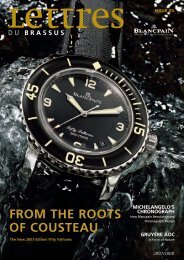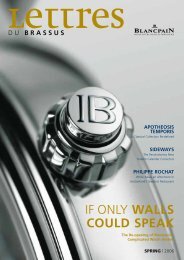THE HISTORY OF BLANCPAIN
THE HISTORY OF BLANCPAIN
THE HISTORY OF BLANCPAIN
You also want an ePaper? Increase the reach of your titles
YUMPU automatically turns print PDFs into web optimized ePapers that Google loves.
ART DE VIVRE<br />
Though Madagascar’s production is very<br />
low (about 5,000 metric tons), it is highly<br />
sought-after. It is unique on the market in<br />
that it has freed itself from the bonds of<br />
world prices, and the price per metric ton<br />
(2,500 euros) is double that of cocoa from<br />
the Ivory Coast (1,300 euros).<br />
Unlike the price of cocoa from other producing<br />
countries, that of Madagascar’s product<br />
is not negotiated and does not fluctuate<br />
on the exchange. Thanks to the cocoa’s<br />
sensory qualities, it has a typical aroma and<br />
taste that are very desirable to chocolate<br />
makers. The success of Madagascar’s cocoa<br />
also arises from its exotic side: the very name<br />
“Madagascar” makes one dream, and<br />
therefore is a selling point from a marketing<br />
perspective. In addition, the island has<br />
organically certified plantations, which are<br />
still rare.<br />
So there are many advantages, which<br />
give much reason to hope provided that<br />
the industry works its way up by implementing<br />
sustainability standards for<br />
producing quality cocoa that is traceable<br />
and certifiable, with specifications for<br />
the rules of production. In Europe, large<br />
importers such as Ecom are acting as<br />
liaisons between the cooperatives and<br />
the final users, and are making technical and<br />
financial commitments to help the cooperatives<br />
take the road to sustainable production.<br />
The same philosophy is found at Lindt<br />
& Sprüngli, which is involved in projects<br />
touching on social, economic and ecological<br />
aspects. The Swiss company also supports<br />
universities that are working on agronomic<br />
improvements for the plantations.<br />
Mathieu Vidal, then the head of Ecom<br />
purchasing for Africa, met with Florian<br />
Noviasy while in Ambanja. “I wanted to<br />
meet parties involved in the cocoa industry.<br />
Our company is rather involved in fair trade<br />
and we have several initiatives going along<br />
that line. We are looking for cocoa produced<br />
under sustainable social, economic<br />
and environmental conditions. In this context,<br />
we are working with some planters’<br />
cooperatives that have the ability to process<br />
and send the raw material to the FOB (free<br />
on board) point, which implies that the<br />
cooperative itself is an exporter. It is in our<br />
interest to defend the interests of the cooperatives.”<br />
The same story is told in<br />
Kilchberg, where the talk is of a “win-win”<br />
situation, meaning that, from production to<br />
processing, there is something in it for<br />
everyone. Mathieu Vidal feels that ADAPS’







